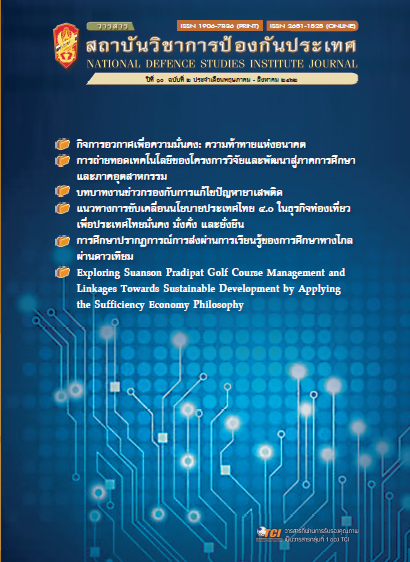Exploring Suanson Pradipat Golf Course Management and Linkages Towards Sustainable Development by Applying the Sufficiency Economy Philosophy
Main Article Content
Abstract
There is limited academic research in the emerging field of sport for development. However,
a growing trend in the past decade recognizes that sport has demonstrated a linkage to sustainable
development. This study aims to: measure service quality and evaluate customer’s satisfaction of
Suanson Pradipat Golf Course by the Royal Thai Army, by using SERVQUAL as a tool; and to determine
an approach for Suanson Pradipat golf course on potential changes as an enabler towards sustainable
development by applying the Sufficiency Economy Philosophy of the Late King Bhumibol Adulyadej
of the Kingdom of Thailand.
Four hundred questionnaires on service quality factors were asked to customers: Tangibles;
Reliability; Responsiveness; Assurance; and Empathy. Results from factor analysis demonstrated that
‘Tangibles’ was the most outstanding factor with Eigenvalues 7.980, compared to other factors at 1.966
to 1.040. Standardized factor loading represented that ‘Readiness of staff’-focused on human resources placed the highest value. Consecutively, the conceptual ‘Sustainability Integrated Management (SIM)
Approach’ for the Suanson Pradipat was proposed. Research findings highlighted that ‘People’ was
the key success factor to both golf course management and the organization’s sustainability.
Research findings concluded that Suanson Pradipat golf courses could adopt the Sufficiency
Economy Philosophy while promoting responsible business practice. People in the local community should be viewed as a stakeholder, and incorporated within the organization policy. The state-owned golf course could represent a good balance in profit, sustainability, good governance, risk mitigation, and social responsibility.
Article Details
References
Avery, G.C. and H.B. Bergsteiner. (2016). “Practices for Enhancing Resilience and Performance”. In G. C. Avery,
and H. Bergsteiner (eds.), Sufficiency Thinking: Thailand’s Gift to an Unsustainable World. (235-247). Crows
Nest: Allen & Unwin.
CAI, Kasetsart University. (n.d.). Case Study Sampran Model. Retrieved November 24, 2017, from
http://www.cai.ku.ac.th/download/Sampran-Model.pdf.
Drucker, P.F. (2006). “They’re Not Employees, They’re people”. Harvard Business Review. 84(2), 152. In G.C.
Avery, and H. Bergsteiner (eds.), Sufficiency Thinking: Thailand’s Gift to an Unsustainable World. (235-247).
Crows Nest: Allen & Unwin.
Hua Hin Municipality. (2010). Demographic Information based on Data Census. Retrieved December 12, 2017,
from www.huahin.go.th
Ministry of Foreign Affairs, Kingdom of Thailand. (2017). Sufficiency Economy Philosophy: Thailand’s Path
towards Sustainable Development Goals (2nd ed). The Bangkok Post: Bangkok.
Office of the Prime Minister. (2016). Report of 2 Year Achievements by the Royal Thai Government during 2014-
(Prime Minister General Prayuth Chan-ocha). In Thai language. Bangkok.
Parasuraman, A., V.A. Zeithaml and L.L. Berry. (1985). “A Conceptual Model of Service Quality and Its Implication
for Future Research”. Journal of Marketing, 49(3).
_______. 1985. “Problems and Strategies in Service Marketing”. Journal of Marketing, 49(3), 25-46.
_______. 1988.“SERVAUAL: A Multiple-Item Scale for Measuring Consumer Perceptions of Service Quality”. Journal
of Retailing, 67(4), 421-450.
Royal Thai Army Sports Center Suanson Pradipat. (2017). Seapine Golf Course: Royal Thai Army Sports Center
Suanson Pradipat-Golf Course and Hotel. Retrived December 14, 2017, from
https://sportarmy.wordpress.com/about/
Ryan, P. and Wayuparb, N. (2004). “Green space sustainability in Thailand”. Sustainable Development Journal, 12,
-237.
UNEP and Chernushenko, D. (2000). Greening Our Games: Running Sport Events and Facilities that Won’t Cost
the Earth. Ottawa.
United Nations Office on Sport for Development and Peace. (2017). Sport and the SDGs. An Overview
Outlining the contribution of Sport and the SDGs. Retrived December 14, 2017, from https://
www.un.org/sport/sites/www.un.org.sport/files/ckfiles/files/Sport_for_SDGs_finalversion9.pdf.
United Nations Sustainable Development Platform. (2017). Sustainable Development. Retrived December 2, 2017,

